Just as different parts of the UK will see different economic impacts from the coronavirus pandemic, this is also the case for different areas within Wales.
This article looks at what data for local authorities can tell us about how different parts of Wales are being affected in terms of unemployment, workers being furloughed, available job vacancies, temporary business closures in ‘shutdown sectors’, and reductions in economic output.
While there are variations between areas and measures, local authorities in rural areas and the Valleys tend to be those most economically affected by the pandemic so far.
Impact on the workforce
The most up-to-date unemployment indicator is the claimant count, although this has some limitations. It includes people who are either claiming Job Seeker’s Allowance or are required to search for work as a condition of receiving Universal Credit.
As there have been some changes to Universal Credit in recent months, the ONS suggests that this may have increased the number of people in work eligible for Universal Credit who would be included in the claimant count. This means that not all of the increase over the last few months will be due to an increase in unemployment.
In August 2020, Newport had the highest claimant count rate among Welsh local authorities at 7.8% of people aged 16-64 (up from 4.2% in March 2020), followed by Merthyr Tydfil, Blaenau Gwent and Conwy.
Between March and August 2020, the claimant count rose in all Welsh local authorities and doubled in 13 of the 22 Welsh local authorities. The claimant count in Powys in August 2020 was over two and a half times higher than in March 2020. The greatest increases across Wales were seen between March and April, at the start of the pandemic, with smaller increases over the last few months.
Cardiff and some local authorities in the Valleys and rural areas have seen some of the largest percentage point increases in the clamant count rate between March 2020 and August 2020.
Figure 1: Claimant count as a percentage of 16-64 year olds, August 2020

Figure 2: Percentage change in claimant count between March 2020 and August 2020
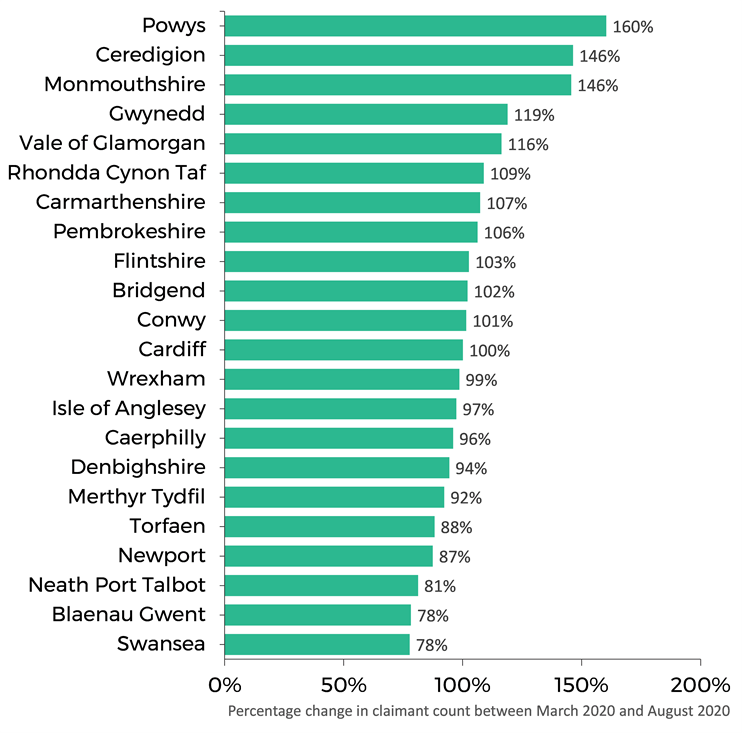
Figure 3: Percentage point change in the claimant count rate between March 2020 and August 2020
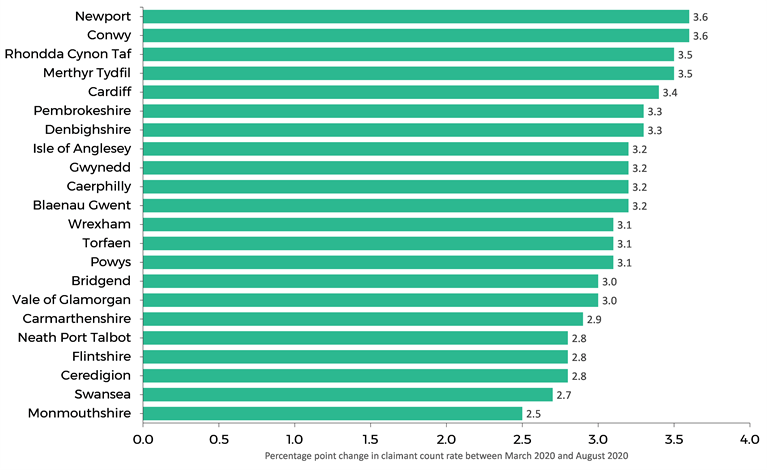
Source for maps and graphs in figures 1-3: Office for National Statistics, NOMIS – Claimant count by sex and age
The UK Government has sought to protect jobs and incomes through the Coronavirus Job Retention Scheme (CJRS), or ‘furlough’ scheme, under which it has paid some workers the majority of their wages since the start of the pandemic. In a number of local authorities, the majority of which are rural, over 30% of jobs have been supported through this scheme for at least some of the time between March and June 2020.
Figure 4: Percentage of jobs supported by the Coronavirus Job Retention Scheme between March and June 2020 in each Welsh local authority

Source: HM Revenue and Customs, Coronavirus Job Retention Scheme statistics: August 2020
For those looking for work, job vacancies are also considerably lower than before the pandemic in some parts of Wales, although the Institute for Employment Studies (IES) reports that there are “tentative signs of recovery in the labour market as lockdown measures have been eased”.
The IES has found that three Welsh local authorities – Newport, Torfaen and Carmarthenshire - had less than half the level of vacancies in August compared to mid-March, and 17 of the 22 Welsh local authorities had fewer vacancies in August than in mid-March. However, all Welsh local authorities had more vacancies in August than in July, with authorities in south Wales seeing the largest increases.
The IES also highlights that, in common with other post-industrial areas in the Scottish central belt and northern England, parts of the Valleys have particularly high numbers of unemployed people per job vacancy available. In particular, Rhondda Cynon Taf and Merthyr Tydfil have 37 and 35 claimants per job vacancy available respectively.
Impact on businesses and sectors
In March 2020 the Welsh Government ordered the temporary closure of businesses in a number of sectors, such as pubs, restaurants, holiday accommodation and non-essential retail. Following the lockdown period, some businesses started to reopen from May, with others being allowed to reopen more recently, while a small minority of business premises (such as theatres, nightclubs and live music venues) remain closed.
Local authorities in the Valleys and north Wales have the highest percentage of businesses in sectors that were required to close during the pandemic. In Conwy and Neath Port Talbot, 23% of businesses are in these ‘shutdown sectors’.
The ‘shutdown sectors’ employ over 20% of the workforce in Gwynedd and Pembrokeshire, and employ the lowest percentage of the workforce in Valleys local authorities.
Figure 5: Percentage of businesses in sectors required to close, 2019
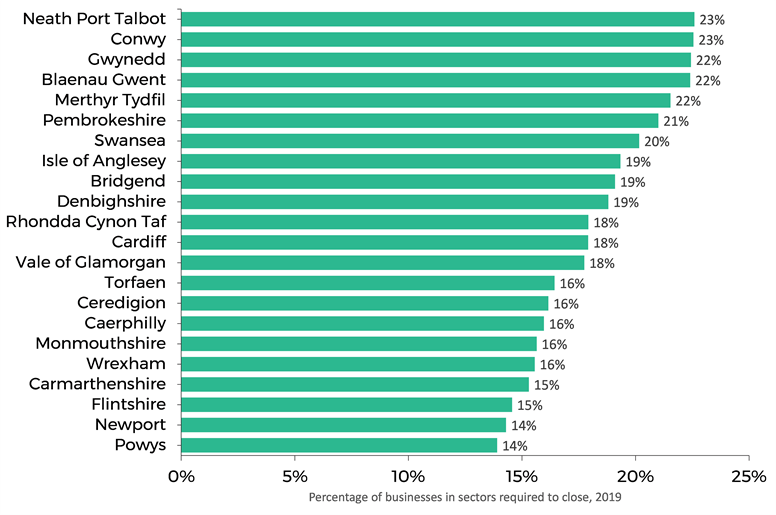
Source: Research Service analysis of Office for National Statistics, NOMIS – UK Business Counts – Enterprises by industry and employment size band, using ‘shutdown sector’ classifications from Welsh Government, Coronavirus and employment: analysis of protected characteristics
Figure 6: Percentage of the workforce employed in sectors required to close, 2019
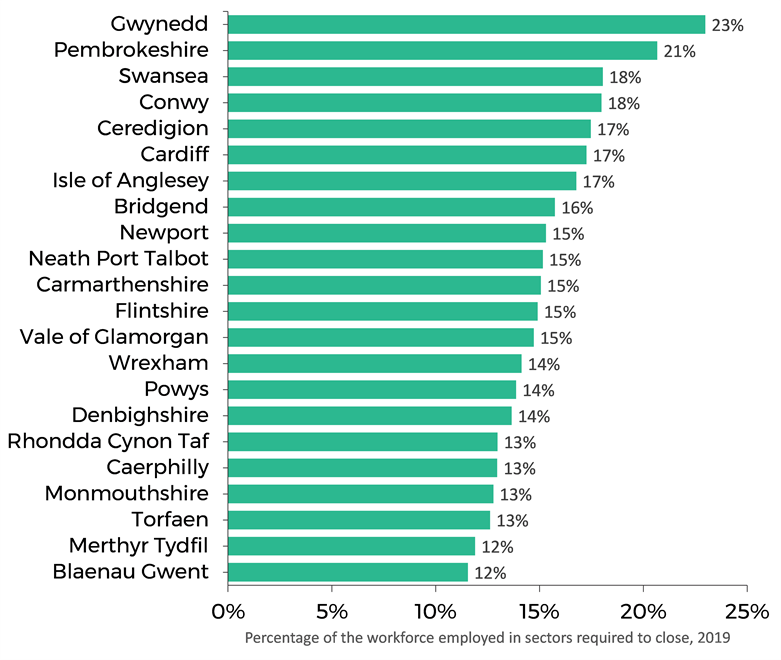
Source: Research Service analysis from Welsh Government, Coronavirus and employment: analysis of protected characteristics and Office for National Statistics, NOMIS – Annual Population Survey
Impact on economic output
In April-June 2020, UK Gross Domestic Product (GDP) fell by 20.4%, the largest fall seen since the Office for National Statistics started publishing quarterly data in 1955. The UK is now in recession, following two quarters where GDP has decreased.
The sectors of the economy that saw a quarterly decrease in GDP of 30% or more were Food and Accommodation; Other Services (including Arts, Entertainment and Recreation); Construction; and Education. In addition, Health and Social Work; Professional and Science; Manufacturing; and Retail and Wholesale saw quarterly decreases in GDP of between 20-30%.
Looking at the ONS’ local authority figures for economic output, the graph below shows that industrial and rural authorities have the largest percentage of economic output in the sectors outlined above. In contrast, the two largest cities within Wales were amongst the authorities with the lowest percentage of economic output in affected sectors.
Figure 7: Percentage of 2018 economic output in sectors that saw the largest GDP decreases in April-June 2020
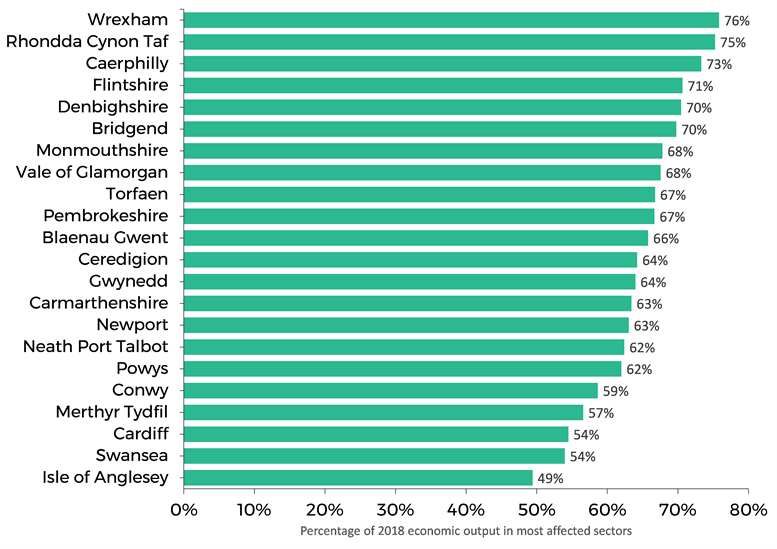
Source: Research Service analysis from Office for National Statistics, GDP first quarterly estimate, UK: April to June 20 and Regional gross value added (balanced) by industry: local authorities by NUTS1 region
Recessions can impact the economy for a number of years afterwards. For example, after the 2008 recession, which saw a smaller overall fall in economic output than the current one, it took until the middle of 2013 for the UK economy to recover to the size it was before the recession.
The Centre for Progressive Policy states that some local authorities in Wales may take a considerable period of time to recover lost GVA. It suggests that Blaenau Gwent, Merthyr Tydfil, Newport, Pembrokeshire and Rhondda Cynon Taf are the most vulnerable local authorities in Wales to “longer-term economic scarring”. It also identifies potential underlying factors that may affect how local areas are able to recover from recession, such as levels of skills and pre-recession unemployment. The Centre for Towns highlights that coastal and ex-industrial towns are particularly likely to have low levels of social and economic resilience, identifying a number of towns in Wales such as Ebbw Vale, Merthyr Tydfil, Mountain Ash, Rhyl and Tredegar as areas facing both short and long-term effects from the pandemic.
Article by Gareth Thomas, Senedd Research, Welsh Parliament
We’ve published a range of material on the coronavirus pandemic, including a post setting out the help and guidance available for people in Wales and a timeline of Welsh and UK governments’ response.
You can see all our coronavirus-related publications by clicking here. All are updated regularly.






